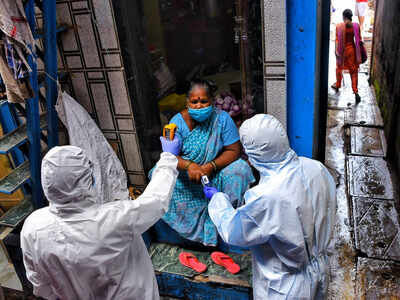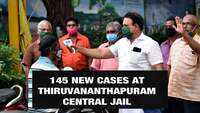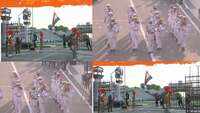
THANE: Nearly five months since the first Covid-19 case was reported in Thane, the city has registered the highest ratio of tests done compared to other urban centres in the district and Mumbai.
A tally found that the collective number of RT-PCR and antigen tests done in Thane is 1.2 lakh or 5.8% of its population (22 lakh), till August 12. In comparison, the neighbouring Dombivli-Kalyan, with a population of around 18 lakh, has done 61,552 tests or 3.4%. Navi Mumbai, with a population of 15 lakh and the third highest number of cases in the Thane district, tested 82,384 residents till August 13, recording 5.4%. A comparison with Mumbai too presented a favourable picture—Mumbai had done 6.5 lakh tests, which covers only 3% of its overall population.
Thane municipal commissioner, Dr Vipin Sharma, said that they have been focusing on increasing surveillance in the city and bringing in more citizens under the ambit of tests. He said the Thane Municipal Corporation (TMC) is aggressively following the protocol of test, track, trace, treat and isolate, which has helped them largely control numbers that were swelling until recently.
Statistics revealed the quantum of tests done rose exponentially in the last two months. “The first case in Thane was detected on March 12. Three months later, numbers rose to 30,309—1.3% of the total population, while in July it rose to 60,178 or 2.7%. The numbers took a leap and almost doubled after antigen tests were introduced last month, helping us get a clearer picture,” said Sandeep Malvi, TMC deputy municipal commissioner.
Dr Sharma said the increased volume of testing helped them detect patients and suspects at an early stage which, in turn, helped them treat them much before they would require hospitalisation. Consequently, the volume of patients is reducing and Thane has more vacant beds—so we are admitting patients from nearby corporations at our facilities as well, said Dr Sharma.
Activists said the administration should reveal the actual number of residents screened. “The percolation of the tests should have been much higher, considering that five months have elapsed since the outbreak. There should be more clarity on how many residents from each ward have been tested instead of a blanket figure,” said a resident.
(All figures as of August 12.
With data inputs by Pradeep Gupta & B B Nayak)
A tally found that the collective number of RT-PCR and antigen tests done in Thane is 1.2 lakh or 5.8% of its population (22 lakh), till August 12. In comparison, the neighbouring Dombivli-Kalyan, with a population of around 18 lakh, has done 61,552 tests or 3.4%. Navi Mumbai, with a population of 15 lakh and the third highest number of cases in the Thane district, tested 82,384 residents till August 13, recording 5.4%. A comparison with Mumbai too presented a favourable picture—Mumbai had done 6.5 lakh tests, which covers only 3% of its overall population.
Thane municipal commissioner, Dr Vipin Sharma, said that they have been focusing on increasing surveillance in the city and bringing in more citizens under the ambit of tests. He said the Thane Municipal Corporation (TMC) is aggressively following the protocol of test, track, trace, treat and isolate, which has helped them largely control numbers that were swelling until recently.
Statistics revealed the quantum of tests done rose exponentially in the last two months. “The first case in Thane was detected on March 12. Three months later, numbers rose to 30,309—1.3% of the total population, while in July it rose to 60,178 or 2.7%. The numbers took a leap and almost doubled after antigen tests were introduced last month, helping us get a clearer picture,” said Sandeep Malvi, TMC deputy municipal commissioner.
Dr Sharma said the increased volume of testing helped them detect patients and suspects at an early stage which, in turn, helped them treat them much before they would require hospitalisation. Consequently, the volume of patients is reducing and Thane has more vacant beds—so we are admitting patients from nearby corporations at our facilities as well, said Dr Sharma.
Activists said the administration should reveal the actual number of residents screened. “The percolation of the tests should have been much higher, considering that five months have elapsed since the outbreak. There should be more clarity on how many residents from each ward have been tested instead of a blanket figure,” said a resident.
(All figures as of August 12.
With data inputs by Pradeep Gupta & B B Nayak)

Coronavirus outbreak
Trending Topics
LATEST VIDEOS
City
 145 inmates test positive in a day, Thiruvananthapuram central prison remains Covid-19 hotbed
145 inmates test positive in a day, Thiruvananthapuram central prison remains Covid-19 hotbed  Hundreds of birds injured due to banned manjha on Independence Day in Delhi
Hundreds of birds injured due to banned manjha on Independence Day in Delhi  Karnataka: Terrifying abduction of a woman in broad daylight caught on cam
Karnataka: Terrifying abduction of a woman in broad daylight caught on cam  Independence Day 2020: Beating retreat ceremony at Attari-Wagah Border as a part of celebrations
Independence Day 2020: Beating retreat ceremony at Attari-Wagah Border as a part of celebrations
More from TOI
Navbharat Times
Featured Today in Travel
Quick Links
Kerala Coronavirus Helpline NumberHaryana Coronavirus Helpline NumberUP Coronavirus Helpline NumberBareilly NewsBhopal NewsCoronavirus in DelhiCoronavirus in HyderabadCoronavirus in IndiaCoronavirus symptomsCoronavirusRajasthan Coronavirus Helpline NumberAditya ThackerayShiv SenaFire in MumbaiAP Coronavirus Helpline NumberArvind KejriwalJammu Kashmir Coronavirus Helpline NumberSrinagar encounter
Get the app



